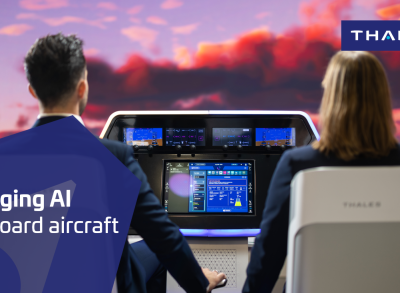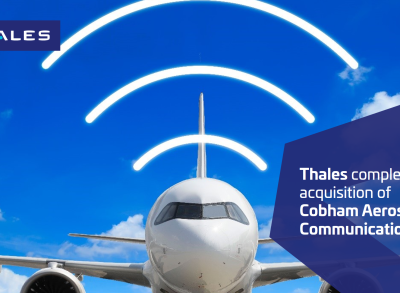Connectivity, a need shared by civil and military aviation
Interoperability among people and equipment, access to information and tools to help with decision-making, wherever you are and whatever system you are using: connectivity is crucial for civil and military aviation, both in flight and on the ground.

They are already equipped with Air Traffic Management tools, but airline pilots must also have access to new methods of communication based on datalink. As it is in contact with airline operations centres, data providers, and airports, as well as industrial service providers who handle maintenance and refuelling, the aircraft will be able to fly in heightened safety and operational performance conditions. It will also fly at a lower cost, thanks to the predictive maintenance tools to which it will be connected, and which will allow real-time management of a fleet of aircraft.
Such tools are especially useful for the business aviation segment, which does not have Operations Control Centres and whose pilots have to manage the entire range of parameters for a mission, both in flight and on the ground. As it happens, connectivity to the ground by crews is currently improving with systems such as the Electronic Flight Bag.
Cabin connectivity, a strategic commercial tool
Connectivity is also essential inside the cabin. Whether it is for the comfort of VIP passengers (business aviation, first and business classes, etc.) who need to stay in touch with the office, or less affluent passengers who are nonetheless increasingly dependent on internet services, customers are now making it very clear that in-flight WiFi is a high priority.
This also applies to the usual services offered by smartphones. The absence of network is now a major differentiating factor for passengers.
Similarly, in-flight entertainment is a strategic tool with regards to airline customers. The diversity of offers in terms of content and the ability to broadcast live events to passengers are now essential differentiating factors, and a high priority for airlines. Passenger preference statistics collected inside aircraft cabins are very precious because they allow airlines to fine tune their offer.
Armed forces: an operational revolution using a "collaborative" C4ISR
Connectivity has been the key focus of the digital revolution for the last twenty years, and has vastly increased army capabilities. However, it is only just getting started.
Information sharing on a system of systems, through secure communication channels, will increasingly facilitate optimal resource coordination. Benefiting from the same perception of the environment, whether this involves army equipment, enemy equipment, or geomorphological and climate conditions, units will be able to use these tools to manoeuvre in coordination. Through these channels, offering shared access to an internet environment designed for defence and making use of applicable Big Data, we can expect to see a very significantly shortened OODA loop. As part of the "collaborative" C4ISR, both rotorcraft and fixed-wing aircraft will be able to interact with various types of drones (combat, ISR, etc.). They will need to exchange an increasing amount of information, but will eventually be fitted with more reliable sensors that use sophisticated artificial intelligence with enhanced built-in calculation capabilities to carry out their missions with ever greater autonomy. All of these air-based resources will form part of a single command system that will also handle inter-army missions, aircraft in other forces (land army, navy, etc.), as well as their sensors and satellite link-ups.
This acute and constant insight into the status of each unit (ammunition status, refuelling, attrition rate, etc.) will mean that resources can be managed better and more quickly (missions will be adjusted, aircraft with different priority for in-flight refuelling, etc.) and, as in the world of civil aviation, predictive maintenance systems can be put into place. All these measures will also improve the equipment's operational condition.
Whether it applies to extremely complex inter-army coalition operations or the management of aircraft and crew needs, connectivity is a key to collaborative combat, and will ensure its success in the future.
Find us on Twitter @ThalesAerospace, on our official Youtube channel Onboard TV and on LinkedIn Thales Aerospace.




